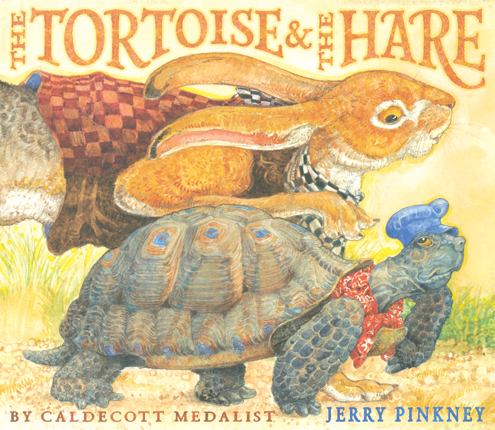Full Text Reviews: Booklist - 08/01/2013 *Starred Review* After his Caldecott triumph with The Lion & the Mouse (2009), Pinkney returns to Aesop for inspiration, this time setting the familiar story in the American Southwest. The endpapers indicate the race route around a cacti-laden barnyard, and the title page shows our titular competitors setting the challenge, before taking off, cheered on by a group of avid animal spectators. The fable plays out as expected, and Pinkney alternates the action between the tortoise’s diligence and the hare’s overconfidence. To mark the tortoise’s progress, Pinkney unveils the moral of the story cumulatively, beginning with just the word slow and adding another word to the phrase at each milestone, until, at contest’s end, the entire phrase “slow and steady wins the race” celebrates the tortoise’s victory. The tortoise sports an engineer’s cap and kerchief; the hare, a checkered vest; and most of the other animals, a variety of town and country clothing, adding a note of homespun vibrancy to Pinkney’s elegant watercolor paintings. Adjacent to an informative artist’s note, we see the hare tying a checkered flag about the tortoise’s neck, and the final endpapers depict a victory party. The tortoise may have won the race, but the real winner here is the listening and viewing audience. HIGH-DEMAND BACKSTORY: Pinkney took home the Caldecott Medal for The Lion & the Mouse, so expect lots of buzz about this companion picture book. - Copyright 2013 Booklist. School Library Journal - 09/01/2013 PreS-Gr 3—Following up on his superb rendition of The Lion & the Mouse (Little, Brown, 2009), Pinkney has created yet another stunning interpretation of a classic tale in this virtually wordless picture book. Endpapers establish the desert setting with a map of the course through the cacti and rocky region of the American Southwest. Tortoise and Hare, each sporting a bandana, are joined by their animal friends at the starting line for the famous race. Fox in his broad-brimmed hat gives them their marks, gets them set, and off they go as Hare bounds away, leaving Tortoise behind in a trail of dust. Pinkney uses watercolor, colored pencil, and pastel paintings to create vibrant characters that are in colorful contrast to the tans and natural browns of the desert. Long horizontal lines and Hare leaping off the page propel the story-and the race-ever forward. The limited text, used sparingly but extremely effectively, reinforces the theme of the story-that the journey is as important as the ultimate goal-and builds one word at a time: "slow," "slow and," "slow and steady" until finally the race is won to the cheers and high-fives of the supportive spectators. Pinkney takes care to show Tortoise overcoming challenges and Hare demonstrating good sportsmanship and healthy competition. An artist's note explains the creative process and motivation for retelling the well-known tale. This spectacular success is certain to become a classic in its own right.—Kristine M. Casper, Huntington Public Library, NY - Copyright 2013 Publishers Weekly, Library Journal and/or School Library Journal used with permission. Bulletin for the Center... - 01/01/2014 Continuing his swath through legend after his Caldecott-winning The Lion and the Mouse (BCCB 2/09), Pinkney here tackles Aesop’s famous fable of the tortoise and the hare, setting the story in a vivid Southwestern landscape of cactus, streaming sun, and wide-open country. Aside from Coyote’s spoken “On your marks . . .” call, the only text is the famous moral, “Slow and steady wins the race,” which winds in part and full through the tortoise’s scenes to describe, promise, and summarize. Pinkney’s note explains he first heard this tale as an Uncle Remus tale, and indeed, his richly characterized animals here recall his illustrations for Julius Lester’s Uncle Remus retellings (The Last Tales of Uncle Remus, BCCB 2/94, etc.). Sassy touches of clothing personify the competitors and their teeming audience (Tortoise sports a denim cap and a jaunty neckerchief, while Hare is a fan of checks, even loaning his checkered scarf to Coyote for a finish flag), yet the anthropomorphism blends seamlessly with the naturalistic detail as Hare springs with power and grace over fallen objects and Tortoise clambers determinedly over rocky ground. Fine detailing has the dimension of Steve Jenkins’ cut-paper work, with the gleaming geometry of Tortoise’s shell as inviting as Hare’s creamy golden fur, but the scope of the illustrations makes the book a compelling distance show as well. This adaptation ends on a nice comradely note, with Hare bestowing his checkered scarf on a pleased Tortoise; don’t miss the closing endpaper, where the victory party is in full swing. While this is an oft-retold tale in picture-book land, Pinkney’s version is faithful to the original while offering a lively and imaginative take on the ancient Greek version of “You snooze, you lose.” DS - Copyright 2014 The Board of Trustees of the University of Illinois. Loading...
|



